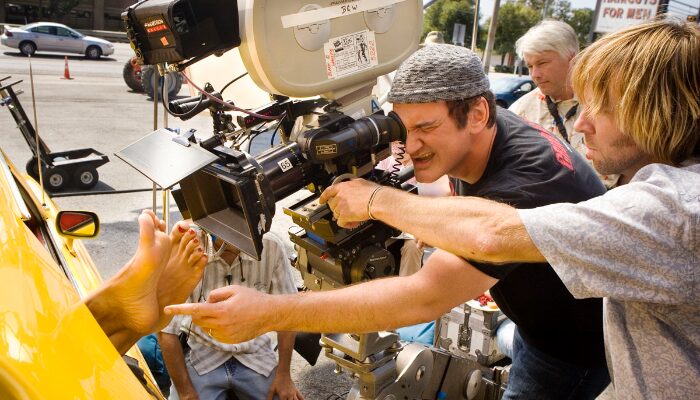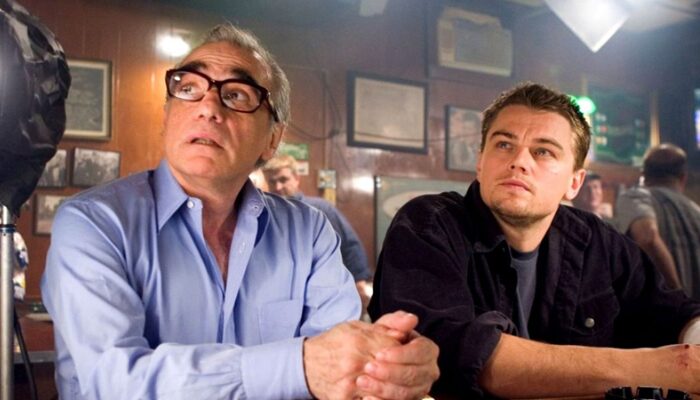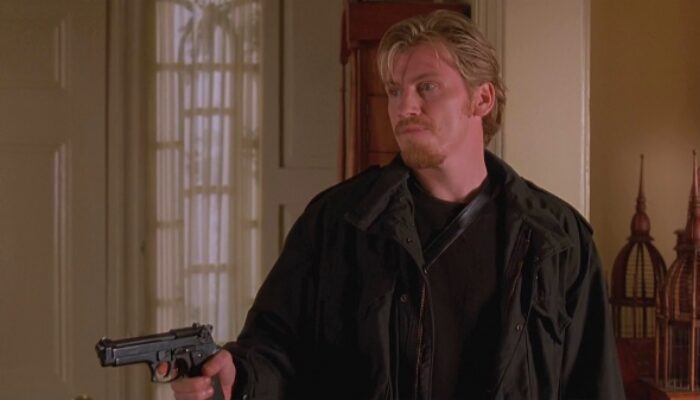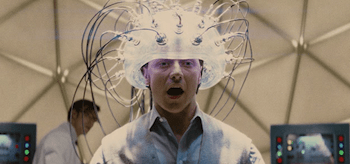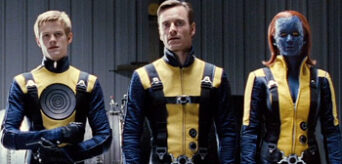Film Review: X-MEN: FIRST CLASS (2011): Matthew Vaughn, James McAvoy
X-Men: First Class (2011) Film Review, a movie directed by Matthew Vaughn and starring James McAvoy, Michael Fassbender, Kevin Bacon, January Jones, Jennifer Lawrence, Rose Bryne, Oliver Platt, Nicholas Hoult, Caleb Landry Jones, Lucas Till, Edi Gathegi, Jason Flemyng, Morgan Lily, Zoe Kravitz, and Bill Bilner.
The first act of X-Men: First Class is an excellent single-note, centralized drama while the remaining two acts of the film are a hodgepodge of answered-before-asked questions in addition to X-Men movie continuity errors, starting with the Jean Grey/Professor X/Magneto segment at the beginning of Brett Ratner’s X-Men: The Last Stand (written about here: Film Review: X-Men: The Last Stand).
Keeping the above in mind, X-Men: First Class can be broken down into three parts, not to be confused with its three acts: Erik Lehnsherr (Michael Fassbender)’s back story and revenge, Professor X (James McAvoy)’s evolution, and The Hellfire Club’s mutant utopia plan.
Recognizing how much the beginning of Bryan Singer’s X-Men grounded the film in reality and was necessary for Lehnsherr’s history, that re-created plot point adorns the initiation of X-Men: First Class. X-Men: First Class started out as X-Men Origins: Magneto then grew deformed to include other marginal mutants and sub-storylines, a terrible mistake as Lehnsherr’s segment of the film shows: no other storyline in X-Men: First Class matches his, not even its heel-nipping, possible usurper plotline surrounding the evil-doers in the film, The Hellfire Club. Seeing what happens directly after the traumatic concentration camp, gate-bending moment in Lehnsherr’s life in 1944 Poland was an ingenious inclusion by director Matthew Vaughn.
Lehnsherr is the only interesting (by “interesting” I mean a character whose personality subtext is actually explored) person in the film, bestowed with the singular, noteworthy character arc. Most viewers can understand wanting revenge, especially after the extended period of mental and physical torture Lehnsherr probably endured.
Raven Darkholme/Mystique (Jennifer Lawrence) is given a false depth even though a small portion of her childhood is shown. It is never mentioned why she ran away from her home, why she (Morgan Lily) is breaking into houses, how Xavier convinced his parents to take her in, and why she didn’t go to school like Xavier since she could disguise herself so convincing, even at a young age.
Since we are on the subject of unanswered questions, how did Lehnsherr escape the dastardly clutches of Dr. Schmidt/Sebastian Shaw (Kevin Bacon)? Why would Shaw let his prize escape? How did Lehnsherr gain the intelligence on the Germans he goes after? These questions would have been answered in X-Men: Origins: Magneto but were left by the wayside in X-Men: First Class. A Jew out for revenge from the World War II era sings of Quentin Tarantino’s Inglourious Basterds (which consequently, Fassender also starred in), undercover Mossad operatives from Assaf Bernstein’s The Debt, and former Nazis on the run and the people hunting them from Brian Moore’s book The Statement.
One of Lehnsherr’s best moments in the film is when he refers to himself as Frankenstein’s monster. He announces to his victims and to the viewer that he is completely self-aware of what he is, the gravity of his actions yet doesn’t care, and that he intends to continue down his narcissistic path.
As was mentioned earlier, the first act of X-Men: First Class is its strongest act and its two most memorable moments involve Lehnsherr: the bar brawl scene and nighttime submarine grab. The bar scene accelerates in a predictable way but when Lehnsherr sneaks onboard Shaw’s yacht, its anything but ordinary. It crescendos beautifully with Lehnsherr not willing to let go of the person he has hated for so long. This was one of the best actions scenes in the film because unlike the other action scenes, this one had an emotional under current to it (no pun intended).
Professor X is the stout, moral compass for the film, the same one present in the previous X-Men films (X-Men, X2, and X-Men: Last Stand). Unfortunately, his personality does not advance in the film, even as the worlds around him, mutant and human, are in a state of flux.
Professor X’s evolution is the strongest of the weak links in the film. It starts off well enough with a graduate student using his brain to pick up girls but as soon as the first class (a dubious moniker since no one is taught anything pertaining to school, only how to better use and focus their mutant abilities e.g. a wolf learning how to use its fangs) team building begins, the film loses momentum. Even with a special and hilarious cameo, the team building/recruiting segment is empty. A far better example of the way it should have been was The Hellfire Club. Their team was already built and they functioned according to their mutant gifts and their roles in the organization.
Why go around and collect people? A different, cleaner way was needed by X-Men: First Class writers Ashley Edward Miller, Zack Stentz, Jane Goldman, and Matthew Vaughn: have circumstances make their paths cross as they did with Lehnsherr and Professor X. Not to belabor the point but during a global crisis, would Lehnsherr and Professor X really have time to gallivant around the globe to recruit mutants and how did they know those mutants’ abilities would be useful to them and the CIA in their impending struggle with Russia and The Hellfire Club?
Since it was established that this was the First Class film, not the Magneto film, the team building, school filling sequences were almost (almost but not quite) compelled to occur and it is a shame since it would have been more effective the Bryan Singer’s X-Men, Hellfire Club route: teams and personnel already in place. Because The Hellfire Club is already in place, no time is wasted on its members who were destined never to be developed above the surface. This is a pity since pulchritudinous White Queen (Jennifer Lawrence) and demon-colored Azazel (Jason Flemyng) beg to be delved into, for instance: How did Azazel get through life up to that point with drastic red skin and a tail? He and Mystique in X-Men must have a lot in common personality-wise yet he is given no personality – a pity but common. Familiar turf can also be found in The Hellfire Club’s plan of global manipulation, which is very similar, if not identical to Skynet’s plan in The Terminator and T2: Judgment Day: pitting two world powers against each before they realize they are pawns and its too late. It was a brilliant way to incorporate mutants into the world affairs of the 1960’s vis-à-vis the Cuban Missile Crisis.
The vestiges of the 1960’s are all over X-Men: First Class except in the slang used: there is none. No one uses words or shorthand inherent to that time period. This is not a shortcoming of the film because it is never noticed. It is an accoutrement missing that would have added to the favor and era present on screen, as the characters’ wardrobe and hairstyles do.
Though they look the parts, every time young adult characters are on-screen in X-Men: First Class, the movie starts to grind against itself (think Sheriff’s Deputy Olsen from Eli Roth’s Cabin Fever), when Lehnsherr, Charles Xavier, Dr. Moira MacTaggert (Rose Byrne), the CIA, and other government officials (for the most part) are on screen, the film glides and the viewer sees a completely different tone to the film: less commercial, toy, and teen-friendly, more compelling.
Then there was some of the dialogue in the film.
“Take the mutants but leave us normal humans alone.” Death sound.
Nails on a chalkboard. I was surprised no one caught that bad dialogue and cut it, not to mention the naming buffoonery. All of the naming scenes in X-Men: First Class were completely unnecessary, cheesy, and Star Wars: Revenge of the Sith heavy-handed. Look at the opposite of these scenes: The Hellfire Club. They didn’t go around telling everybody’s name and ability. Their names and abilities were shown and given within the context of the film.
X-Men: First Class is the third most well constructed X-Men film behind X2 and X-Men. It is also Matthew Vaughn’s second best film to date (Layer Cake being the first), including Kick-Ass: X-Men: First Class has the realism for a comic book movie that Kick-Ass lacked.
Rating: 7.5/10
For more X-Men: First Class videos, photos, and information, check out our X-Men: First Class Page.
Related Articles
FilmBook's Newsletter
Subscribe to FilmBook’s Daily Newsletter for the latest news!


